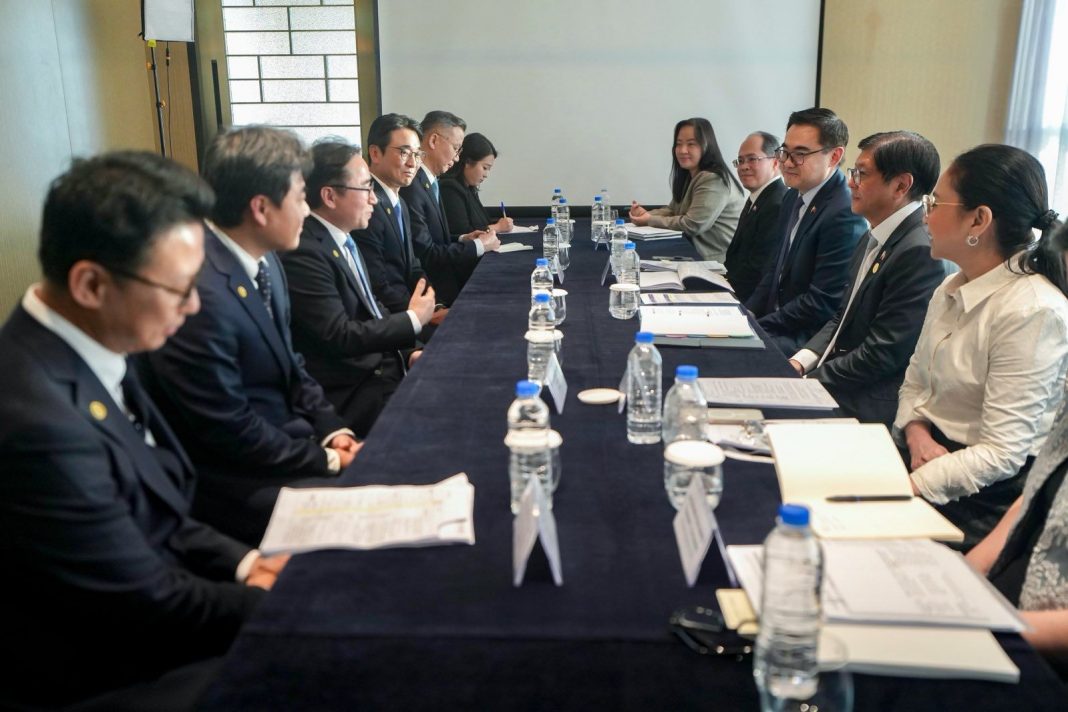Samsung, Korea’s electronics manufacturing giant, is investing PHP50.7 billion to expand its existing manufacturing operations in the Philippines with the establishment of a state-of-the-art, high-technology manufacturing facility to produce automotive multilayer ceramic capacitors (MLCCs) — key components used in electric vehicles (EVs) and smart devices.
Special Assistant to the President for Investment and Economic Affairs Frederick D. Go said Presidential Incentive were finalized following President Marcos’ meeting with top executives of Samsung Electro-Mechanics Co., Ltd. (SEMCO) on the sidelines of the 32nd APEC Summit in South Korea.
Together with President Marcos, Secretary Go and Department of Trade and Industry (DTI) Secretary Cristina A. Roque, also witnessed the signing of a Supplemental Agreement between the DTI’s Philippine Economic Zone Authority (PEZA) and SEMPHIL.
The project is expected to begin commercial operations by July 2027 and create over 3,500 high-quality jobs for Filipino workers.
The SEMPHIL expansion is the first project to be granted Presidential Incentives under the CREATE MORE Act (Republic Act No. 12066).
The expansion will be implemented by Samsung Electro-Mechanics Philippine Corporation (SEMPHIL), the local unit of SEMCO in the Philippines.
“Samsung is already in the Philippines, they have employed [thousands of Filipinos] in their very, very high-tech manufacturing plant. The products that they make in the Philippines are of the highest tech that you can imagine. And so that is very, very
important for us,” President Marcos Jr. said in an interview with the Philippine media delegation in South Korea.
“They [Samsung] made a commitment of a little over PhP50 billion to expand. That translates into 3,000 new jobs. And again, the transfer of technology is going to be very important,” the President added.
The Chief Executive also emphasized that Samsung has agreed to tie up with
several universities in the Philippines to train Filipino workers and conduct research and development in the country.
Located in the Calamba Premiere International Park (CPIP) and registered with PEZA, SEMPHIL serves as SEMCO’s main global production hub in a cost-efficient region.
As of December 2024, the SEMPHIL already employs over 7,000 Filipinos and accounts for nearly half of SEMCO’s worldwide MLCC output.
Under the CREATE MORE Act, the President may grant tax incentives in the interest of national economic development or upon the recommendation of the Fiscal Incentives Review Board (FIRB). Qualified projects are eligible for a range of incentives, including Income Tax Holiday (ITH), Special Corporate Income Tax
(SCIT), and Enhanced Tax Deductions. These incentives also cover Value-Added Tax (VAT) zero-rating on local purchases, as well as VAT and duty exemptions on importation.
Secretary Go highlighted the broader significance of the SEMPHIL investment. “This is tangible and a direct outcome of this administration’s landmark policy reforms,” he said. “This development sends a strong message to the global business community: the Philippines is more than open and ready for business. We are competitive and fully capable of hosting world-class, high-technology industries. More importantly, this project embodies our commitment to create more quality jobs for Filipinos,
strengthen our manufacturing base, and deepen our economic partnership with South Korea.”
Echoing this sentiment on the sectoral impact, PEZA Director General Tereso O. Panga hailed the announcement as a “landmark achievement for the country’selectronics sector.” He noted that SEMPHIL’s expansion will “strengthen the
Philippines’ position in the global semiconductor value chain and create more opportunities for Filipino talent.”
According to the Philippine Statistics Authority (PSA), electronic products remained the country’s top export in 2024, accounting for nearly 60% of total shipments. The new SEMPHIL project is expected to boost the Philippines’ share in global MLCC exports, solidifying its position as a reliable and competitive partner in advanced electronics manufacturing.
Meanwhile, the FIRB, chaired by the Department of Finance, emphasized that this milestone demonstrates how the CREATE MORE framework balances competitiveness with fiscal prudence, ensuring that incentives are both targeted and transformative.




